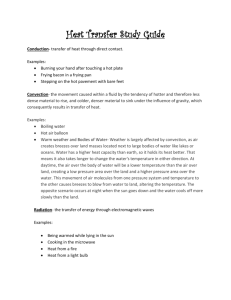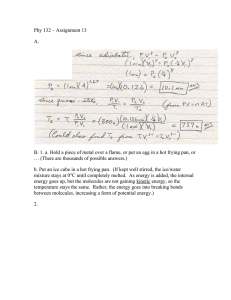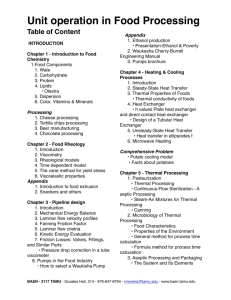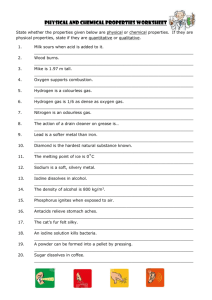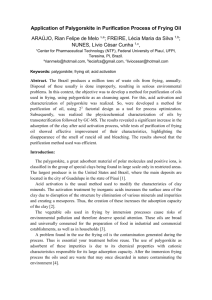Advance Journal of Food Science and Technology 2(1): 22-27, 2010
advertisement
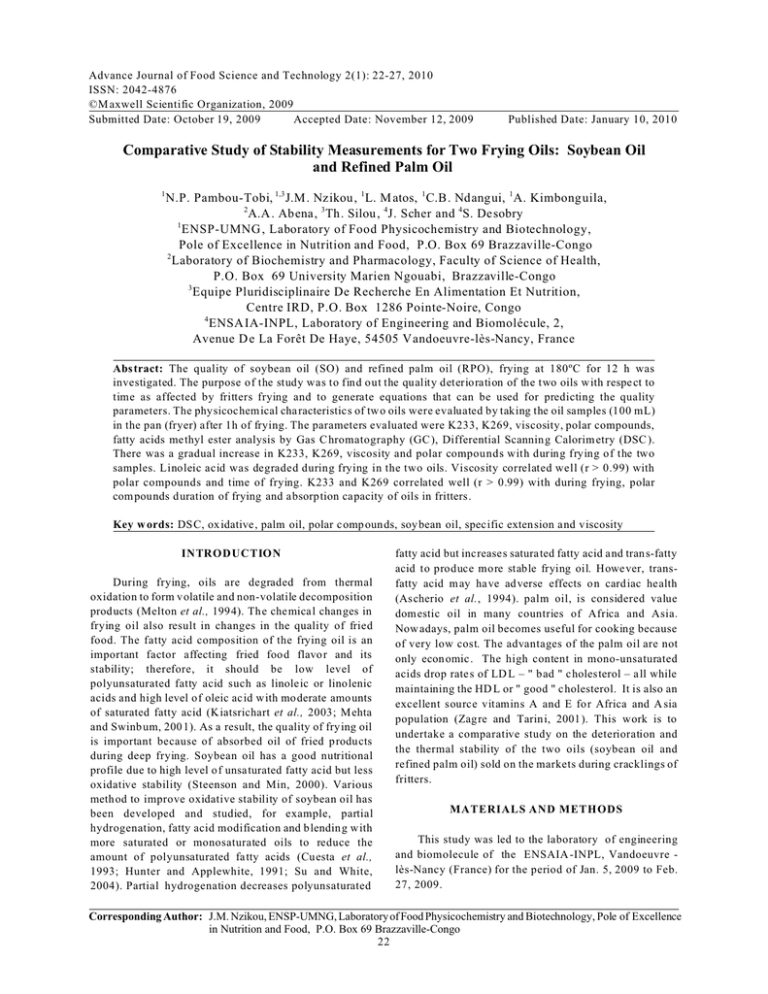
Advance Journal of Food Science and Technology 2(1): 22-27, 2010 ISSN: 2042-4876 ©M axwell Scientific Organization, 2009 Submitted Date: October 19, 2009 Accepted Date: November 12, 2009 Published Date: January 10, 2010 Comparative Study of Stability Measurements for Two Frying Oils: Soybean Oil and Refined Palm Oil 1 N.P. Pambou-Tobi, 1,3 J.M. Nzikou , 1 L. M atos, 1 C.B . Ndangui, 1 A. Kimbong uila, 2 A.A . Abena, 3 Th. Silou, 4 J. Scher and 4 S. Desobry 1 ENSP-UMNG , Laboratory of Food Physicochemistry and Biotechnology, Pole of Excellence in Nutrition and Food, P.O. Box 69 Brazzaville-Congo 2 Laboratory of Biochemistry and Pharmacology, Faculty of Science of Health, P.O. Box 69 University Marien Ngouabi, Brazzaville-Congo 3 Equipe Pluridisciplinaire De Recherche En Alimentation Et Nutrition, Centre IRD, P.O. Box 1286 Pointe-Noire, Congo 4 ENSA IA-INPL, Laboratory of Engineering and Biomolécule, 2, Avenue D e La Forêt De Haye, 54505 Vandoeuvre-lès-Nancy, France Abstract: The quality of soybean oil (SO) and refined palm oil (RPO), frying at 180ºC for 12 h was investigated. The purpose of the study was to find out the quality deterioration of the two oils with respe ct to time as affected by fritters frying and to generate equations that can be used for predicting the quality parameters. The physicochem ical cha racteristics of two oils were evaluated by taking the oil samples (100 mL) in the pan (fryer) after 1h of frying. The parameters evaluated were K233, K269, viscosity, polar compounds, fatty acids methyl ester analysis by Gas C hromatography (GC ), Differential Scanning Calorim etry (DSC ). There was a gradual increase in K233, K269, viscosity and polar compounds with during frying of the two samples. Linoleic acid was degraded during frying in the two oils. Viscosity correlated well (r > 0.99) with polar compounds and time of frying. K233 and K269 correlated well (r > 0.99) with during frying, polar com pounds d uration of frying and absorp tion capacity of oils in fritters. Key w ords: DSC, ox idative, palm oil, polar comp ounds, soy bean oil, specific exten sion and viscosity INTRODUCTION During frying, oils are degraded from thermal oxidation to form v olatile and non-volatile decomposition products (Melton et al., 1994). The chemical changes in frying oil also result in changes in the quality of fried food. The fatty acid composition of the frying oil is an important factor affecting fried food flavo r and its stability; therefore, it should be low level of polyunsaturated fatty acid such as linoleic or linolenic acids and high level of oleic ac id with moderate amo unts of saturated fatty acid (K iatsrichart et al., 2003; Mehta and Swinb um, 200 1). As a result, the quality of frying oil is important because of absorbed oil of fried p roducts during deep frying. Soybean oil has a good nutritional profile due to high level of unsaturated fatty acid but less oxidative stability (Steenson and Min, 2000). Various method to improve oxidative stability of soybean oil has been developed and studied, for example, partial hydrogenation, fatty acid modification and b lending with more saturated or monosaturated oils to reduce the amount of polyunsaturated fatty acids (Cuesta et al., 1993; Hunter and Applewhite, 1991; Su and White, 2004). Partial hydrogenation decreases polyunsaturated fatty acid but increases saturated fatty acid and tran s-fatty acid to produce more stable frying oil. Howe ver, transfatty acid m ay ha ve ad verse effects o n card iac health (Ascherio et al., 1994). palm oil, is considered value dom estic oil in many countries of Africa and Asia. Now adays, palm oil becomes useful for cooking because of very low cost. The advantages of the palm oil are not only econ omic. The high content in mono-unsaturated acids drop rate s of LD L – " b ad " cholesterol – all while maintaining the HD L or " good " cholesterol. It is also an excellent source vitamins A and E for Africa and A sia population (Zagre and Tarini, 2001 ). This work is to undertake a comparative study on the deterioration and the thermal stability of the two oils (soybean oil and refined palm oil) sold on the markets during cracklings of fritters. MATERIALS AND METHODS This study was led to the laboratory of engineering and biomolecule of the ENSAIA -INPL, Vandoeuvre lès-Nancy (France) for the period of Jan. 5, 2009 to Feb. 27, 2009. Corresponding Author: J.M. Nzikou, ENSP-UMNG, Laboratory of Food Physicochemistry and Biotechnology, Pole of Excellence in Nutrition and Food, P.O. Box 69 Brazzaville-Congo 22 Adv. J. Food Sci. Technol., 2(1): 22-27, 2010 for 5 min, then heated from 210 -215ºC at 3ºC minG 1 and finally kept 18 min at the last temperature. Nitrogen was used as carrier gas at a flow rate of 1.0 mL minG 1 . The peak identification was carried out by comparing the peak retention time with those of the standard mixture. An internal standard w as used for the quantification of fatty acids. The GC response factor of each fatty acid was calculated by using the internal standard. The results were expressed as g fatty acid/100 g total fatty acids (%). Food materials: Wheat flour, refined oils of soya and palm, and other ingredients we re purchased at local market "Total of Bacongo" in the southern part of Brazzav ille (Congo). Fritter flour dough preparation: Flour dough prepared from wheat flour (900 g), distilled water (500 mL), salt (2 g), sugar (100 g), baker yeast (10 g) was mixed in a basin (5 L of volum e). Flour dough is fermented, let at rest during 2 h and to b e prep ared at frying. Polar compound measur emen ts: Measurement of polar compounds (in percentag e) was done w ith a rapid method that is, using a Testo Ebro Model type FOM 310 based on dielectric constant measureme nt. This instrum ent allows measurement from 40-210ºC and there is an interpretation that corresponds to every temperature. A number of frying cycles was done until the sensitivity limit of the instrument (40% polar compounds) was reached. Treatment of oils: A series of tests were used to fry the spherical sections of fritters dough (thickness 4 cm). For each test, 300 g of sections of fritters dough w as fried in 5000 mL oil at a temperature of 120ºC; the busy oil ba th of 180ºC before introduction of the se ctions, to 120ºC, to stabilize itself at this temperature. With end of 10 min of frying, the operation is stopped and the taken fritters, drained during 10 min on a grid at ambient temperature. Samples of oil for analysis were taken each morning after the oil had cooled overnight at 20ºC. One sam ple for each oil of frying was collected at day 0, 1, 2, 3, 4, 5, 6, 7, 8, 9, 10, 11 and 12. D ay 0 o il was collecte d after the oil conditioning before the start of the frying. All the oil samples collected were analyzed using the same procedu re used for the initial oil analysis. Taking away carried out each morning, made it possible to follow the oxidative and thermal evolution for two studied oils. During fryin g was 1 h per day. Viscosity measur emen ts: A rheometer as described by Nzikou et al. (2006) was use d to measure the different oil viscosities. By this procedure, a concentric cylinder system is subm erged in the oil and the force necessary to overcome the resistance of the visco sity to the rotation is measured. The viscosity valu e (mP as) is automatically calculated on the basis of the speed and the geometry of the probe. Temperature (20ºC) was controlled with a water bath connected to the rheometer. The experiment was carried out by putting 3 ml of sample in a conc entric cylinder system using 100 secG 1 as shear rate. Diffe rential scan ning c alor im e tr y ( D S C ): Calorimetric evaluations of sample m elting behavior were performed in a Perk in-Elm er (M odel Pyris 1, Perkin Elmer Corp., and Norwalk CT) as described by Nzikou et al. (2007). A ll samples w ere tempered in the D SC cell according to the following c onditions: sam ples were tempered at -50ºC du ring 10 min. DSC analysis w ere performed from -50ºC to +50ºC at a scan rate of 10ºC .minG 1 . The major peak maximum temperatures and enthalpy of melting (J.gG 1 ) were analyzed from thermograms using the Pyris software (version 2.04, 1997). Absorption Cap acity of fritter oils: Absorption Capacity of fritters oils was determined by extraction at solvent (Ndjouenkeu and Ngassoum, 2002). One hundred and fifty gram of ground fritter were placed into a cellulose paper cone and extracted using light petroleum ether (bp 40-60ºC) in a 5-l Soxhlet extractor for 8 h (Pena et al., 1992). The oil was then recovered by evaporating of the solvent using rotary evaporator Model N-1 (Eyela, Tokyo Rikakikal Co., Ltd., Japan) and residual solvent was removed by dry ing in an oven at 60ºC for 1 h and flushing with 99.9% nitrogen. Determ ination of fatty acid composition: Total fatty acids were transmethylated according to Frega and Bocci (2001). About two drops of oil (SO a nd RPO) w ere dissolved in six drops of a so lution of 2 N KOH in methanol and then 2 ml of n-hexane were added. The mixture was vigorously shaken with a vortex for 2 min, sodium sulfate was added and the mixture was shaken again. The sample (0.4 :l) was injected 10 m in later into a gas chromatograph (Hewlett-Packard 5890 CG) equipped with a split-splitless injector and a flame ionization detector. A DB-225, 30 x 0.25 mm ID and 0.15 :m column (J and W Scientific, Agilent) was used. The injector and detector temperatures were set at 250ºC. The oven temperature was kept at 190ºC for 1 min, then programmed from 1 90-210ºC at 4ºC minG 1 , kept at 210ºC Statistical analysis: Each reported value is the mean of determinations for triplicate samples. The statistical analysis of the data, correlation and regression was carried out with Microsoft Excel 8.0 software. RESULATS AND DISCUSSION Fatty acids composition: Table 1 shows the contents of saturated (SFA), monoun saturated (MUFA ), and polyunsaturated (PUFA ) fatty acids of the oils used for the frying experiments. RPO had the highest SFA (45.38%) and MU FA (43%) contents, mainly represented by palmitic (39.65% ) oleic (42.81% ) and linoleic (11.04% ) acids; SO was very rich in PUFA (53.88%) by 23 Adv. J. Food Sci. Technol., 2(1): 22-27, 2010 Tab le 1: F atty an d co mp ositio n (% ) of th e un use d fry ing o ils Oil simples SFA MUFA PUFA SO 11.08±0.02 35.04±0.01 53.88±0.18 RPO 45.38±0.28 43.00±0.12 11.61±0.53 Abb reviations: SFA, saturated fatty acids; MUF A, monounsatured fatty acids; PUFA, polyunsatu rated fatty ac ids.(mean values ± stand ard dev iation s); SO : soy bea n oil, R PO : refine d pa lm o il comparison RPO (11.61%), mainly as linoleic acid, which makes it particularly sensitive to oxidation, while the SO and RPO blend abounded in MUFA that are more stab le toward oxidation reactions (Fatemi and Ham mond , 1980). The most abundant PUFA, linoleic acid, was degraded during frying in the two oils because of lipid oxidation (Fig. 1). By comparison of the slope values shown in the Fig. 1, the highest degradation rate was found for SO, probably due to its lower content of natural antioxidants in comparison to RPO and also probably to the lack of tocotrienols in SO, which are instead present in RPO and act as more effective antioxidant compounds (Rossi et al., 2007). in the ultraviolet absorption K at 233 and 269 nm are associated with the changes in the conjugated dienes and trienes that are produced due to the oxidation of polyunsaturated fatty acids (Abdulkarim et al., 2007). The resulting conjugated dienes exhibit an absorption at 233 nm; similarly the conjugated trienes absorb at 269 nm. The changes in K at 233 and 269 nm during frying for SO, RPO, are shown in Fig. 2 and 3. The K at 233 and 269 nm for the two samples increased with frying time throughout the frying days. The levels of conjugated dienes throughout the frying period are lowest in the two samples. The levels of conjugated trienes are also lowest in the two samples. The low levels of both conjugated dienes and trienes o f both samples are indications of good oxidative stability of the oil, and it is because of the high percentage of mo nounsaturated/oleic acid it contains (35% SO and 43% R PO). The higher the percentage of polyunsaturated acids in the oil, the highe r the levels of conjugated dienes and trienes formed during frying. T his was the reason why SO and RPO, that contained high percentages of polyunsaturated acids (linoleic and linolenic), have accumulated more conjugated dienes and trienes. In contrast, K 2 3 3 and K 2 6 9 , another oxidation index, related to conjugated diene and triene formation, was higher and increased more rapidly in SO , this is in relationship with the higher deg radation rate of linoleic acid observ ed in S O. Changes in the ultraviolet spectrum have been used as a relative measu re of oxidation. Farmer and Sutton (2002) indicated that the absorption increase due to the formation of conjugated dienes and trienes is proportional to the uptake of oxygen and formation of peroxides during the early stages of oxidation. Correlation co efficients (R 2 ) between K at 233 nm and frying during the initial stage of oxidation were found to be positive and very high; at 0.987 and 0.985 respectively for RP O and SO. Specific extinction is thus a very sensitive means of measuring Fig. 1: Relationship between Linoleic acid degradation and the frying during for SO and RPO. Data points represent mean values, Standard deviations ranged between 0% and 0.38%. Fig. 2: Relationship between specific extinction K 233 and the frying during for SO and RPO. Data points represent mean values, Standard deviations ranged between 0.005 and 0.450. Fig. 3: Relationship between specific extinction K 269 and the frying during for SO and RPO. Data points represent mean values, Standard deviations ranged between 0.005 and 0.400. differences of lipid oxidation. It was found that in the two samples, the levels of conjugated dienes are higher than trienes, this is indicated by the higher values of K at 233 n m. Polar com pounds: T he polar compounds are a product of the oxidation and they are determined by a 24 Adv. J. Food Sci. Technol., 2(1): 22-27, 2010 Fig. 6: Relationship between viscosity (measured at 20ºC) and the Polar compounds for SO. Fig. 4: Relationship between Polar compounds and the frying during for SO and RPO. Data points represent mean values, Standard deviations ranged between 0% and 0.35%. Fig. 7: Relationship between viscosity (measured at 20ºC) and the Polar compounds for RPO. SO and R PO , respectively (Fig. 6, 7). Colour and viscosity are the most com mon p hysical param eters used to evaluate the extent of frying o il deterioration in commercial and household frying. They are the most obvious changes that can be observed even for the nonexpert. The degradation of oils during frying affects both viscosity and the com position of polar compounds. For the two samples of oil, a linear equation at summer found. Furthermore, the relationship is very similar for SO and RPO, although for the different percentage of polar compoun ds, and therefore the different degree of oil degradation, the visc osity is slightly lower for SO than for RPO. As both types of oils behave similarly, this shows that the viscosity seems to be more affected by thermodegradation and therefore by the percentage of polar compounds formed through oxidation and thermal and hydrolytic reactions than by the composition of the fatty acids and in particular the degree of unsaturation. Absorption Capacity: The use of two oils for fritters frying of wheat flour seems to indicate a relatively better absorption of RPO (Fig. 8). It would be however hazardous to show a differential absorption from oils by fritter without a preliminary study from the kinetics of absorption. As a whole, the value of absorption of RPO is higher than that of SO. Fig. 5: Relationship between viscosity (measured at 20 / C) and the frying during for SO and RPO. Data points represent mean values, Standard deviations ranged between 0 and 0.7 mPa.s. rapid method (Testo) in order to follow the life of the frying oil. Recently a goo d corre lation of this me thod w ith the official one (by silica column chromatography) was established (Dobarganes, 2007 ). Fig 4 shows the polar compounds content, depending on the frying number. In both oils there is a lineal behaviour with a very good correlation, although the degradation of the two oils occurs sooner, as expected, because of the fatty acid composition. The maximal sensitivity of the instrument was reached after the 12 th frying process. Moreover, the limit established by the French legislation for he ated fats is 25% of polar compounds (Sanchez-Gimeno et al., 2008). Changes viscosity: The visco sity of all the oils increased with frying days (Fig. 5). Increase in viscosity was caused due to the formation of high molecular weight polymers. The more viscous the frying o il, the higher the degree of deterioration. The changes in viscosity in the two oil samples had a positive and high correlation with changes in percent polar compounds during the frying period, with correlation coefficient, of 0.985 and 0.978 for 25 Adv. J. Food Sci. Technol., 2(1): 22-27, 2010 Tab le 2: Thermal parameters of frying oils obtained by differential scanning calorimetry. Experimental conditions: temperature programm set at -50°C for 1 0 m in, risin g to + 50° C a t rate o f 10 °C m inG 1 . Oils samples --------------------------------------------------------------------------------------------------------------------------------------SO RPO ------------------------------------------------------------------------------------------------------------------SO a SO b RPO a RPO b P e ak 1 [° C ] -22.54 -23.72 +0.99 +2.69 H f [J.g G 1 ] +8.40 +9.78 +0.20 +0.93 P e ak 2 [° C ] -5.97 +2.89 H f [J.g G 1 ] +1.09 -1.06 a b a b SO , soybean oil unused: SO , soybean oil used after 1 h of frying: RPO , refine d pa lm o il unused: RPO , refined palm oil used after 1 h of frying. reduce the oxidative and Thermal stability of oil during frying at 180ºC since the parameters values physicochemical of soybean oil are more higher than that of palm oil during frying. ACKNOW LEDGMENTS The authors thank Carole Jea ndel and C arole Perroud, mem bers of the laboratory of eng ineering and biom olecu le of EN SA IA (N ancy -France), of their collaboration in experimental w ork. Fig 8: Relationship between content of fried oil and the oil samples (SO and MO). REFERENCES Abdulkarim, S.M., K. Long, O.M. Lai, S.K.S. Muham mad and H.M. Ghazali, 2007. Frying quality and stability of high-oleic M oringa oleifera seed oil in comparison with other vege table oils. Food Chem ., 105: 1382-1389. Ascherio, A., C.H. Hennekens, J.E. Buring, C . Master, M.J. Stam pfer an d W .C. W illet,1994 . Trans-fatty acid intake and risk of myocardial infraction. Circulation, 89: 94-101. Cuesta, C., F.J. Sanch ez-M uniz, S. Ga rrido-Polonio, S. Lop ez-V arela and R. Arroyo, 1993. Thermoxidative and hydrolytic chan ges in sunflower oil use in frying with a fast turnover of fresh oil. J. Am. Oil Chem. Soc., 70: 1069-1073. Dobarganes, M.C., 2007. Report: Evaluation of Testo 265 for Quality Control of Frying Oils and Fats. CSIC. Farmer, E.H . and D.A. Sutton, 2002. Perox idation in Relation to Oleifenic Structure. 2nd Edn. In: Food lipids: Chemistry, Nutrition and Biotechnology, Akoh, C.C. and D.B. M in, (Eds.), Marcel Dekker, Inc., New Y ork, pp: 470. Fatemi, S.H. and E.G. Hammond, 1980. Analysis of oleate, linoleate and linolenate hydroperoxide in oxized ester mixtures. Lipids, 15: 379-385. Frega, N. and F. Bocci, 2001. A rapid analysis of olive oil. Lab oraty 2 000, Italy, 3: 28. Hun ter, J.E. and T.H. Applewhite, 1991. Reassessment of trans fatty acid availability in the US diet. Am. J. Clin. Nutr., 54: 363-369. Kiatsrichart, S., M.S. Brewer, K.R. Cadwallder and W.E. Artz, 2003. Pan-frying stability of nusun oil, a mid-oleic sunflower oil. J. Am . Oil. Chem . Soc., 80: 479-483. Thermal profiles of oils: The DS C determines these physical properties. Results obtained from the heating with the D SC (Table 2) showed that there is two major peaks at -22.54ºC ( H f = +8.40 J.gG 1 ) (SO a ) and -23.72°C ( H f = +9 .78 J.gG 1 ) (SO b ) and two small peaks at -5.97°C ( H f = +1 .09 J.gG 1 ) (SO a ) and +2.89 °C ( H f = - 1.06 J.gG 1 ) (SO b ) for both oil samples SO a and SO b . The two major peaks represented the melting tem peratu re of un stable crystals of the low melting TAG that pre-maturely melted. The more stable low melting unsaturated TAG crystals melted at a higher temperature shown as peaks at -5.97ºC (SO a ) and +2.89ºC (SO b ). The two major peaks at 22.54ºC (SO a ) and -23.72ºC (SO b ) was due to PUFA presence, while the two small peaks at -5.97ºC (SO a ) and +2.89ºC (SO b ) was correlated to MUFA . The thermal behaviour of this oil w as not significantly affected by frying. The Table 2 has only one major melting point at +0.99 ºC ( H f = +0.20 J.gG 1 ) (RPO a ) and +2.69°C ( H f = +0.93 J.gG 1 ) (RPO b ). Those peaks suggest the presence of mixed triglycerides groups w ith different melting points (Table 2). CONCLUSION The percentage of polar com pounds, conventionally used to measure frying oil degradation, w ere related to viscosity for the two frying oils purchased at local market "Total of Bacongo" in the southern part of B razzaville (Cong o). Gas chromatography (CPG), sp ecific extinction K 2 3 3 and K 2 6 9 and viscosity could be used to characterize the thermal degradation of frying oils. This study demonstrates soyb ean o il and refined p alm oil was able to 26 Adv. J. Food Sci. Technol., 2(1): 22-27, 2010 Mehta, U. and B. Sw inburn, 200 1. A review of factors affecting fat absorption in hot chips.Crit. Rev. Food Sci. Nutr., 41: 133-154. Melton, S.L., S. Jafar, D. Sykes and M.K. Trigiano, 1994. Review of stability measurements for frying oils and fried food flavor. J. Am. Oil. Chem. Soc., 71: 1301-1308. Ndjouenkeu, R. and M . Ngassoum, 2 002. Comparative study of fring behaviour of some vegetable oils. J. Food Eng., 52: 121-125. Nzikou J.M., M . M voula-Tsieri, L. Matos, E. Matouba, A.C. Ngakegni, M. Linder and S. Desobry, 2007. Solanum nigrum L. seeds as an alternative source of edible lipids and nutriment in Congo Brazzaville. J. Appl. Sci., 7: 1107-1115. Nzikou J.M ., M . M v ou la-T sieri, E . M atouba, J.M . Ouamba, C. Kapseu, M. Parmentier and S. Desobry, 2006. A stu dy on gumbo seed grown in Congo Brazzav ille for its food and industrial applications. Afr. J. Biotechn., 5: 2469-2475. Pena, D.G., R.G.L. Anguiano and J.J.M. Arredondo, 1992. Modification of the method AOAC (CBmeth od) for the detection of aflatoxins. Bull. Environ. Contam. Toxicol., 49: 485-489. Rossi, M., C. Alamprese, and S. Ra tti, 2007. Tocopherols and tocotrienols as free radical-scavengers in refined vegetable oils and their stability during deep-fat frying. Food Chem ., 102: 812-817. Sanchez-Gimeno, A.C., A.I. Negueruela, M. Benito, A. Vercet and R. Oria, 2008. Some physical changes in Bajo aragon extra virgin olive oil during the frying process. Food Chem., 110(3): 654-658. Steenson, D.F. and D.B. Min, 2000. Effects of b carotene and lycopene thermal degradation products on the oxidative stability of soyb ean o il. J. Am. Oil. Chem. Soc., 77(11): 1153-1160. Su, C. and P . W hite, 2004. Frying stability of high -oleate and regular soybean oil blends. J. Am. Oil. Chem. Soc., 81:7 83-788. Zagre, N.M. and A. Tarini, 2001. Non refined palm oil: beyond its role for fighting vitamin deficiency. J. Med. Nutr., 37(2): 53-58. 27
